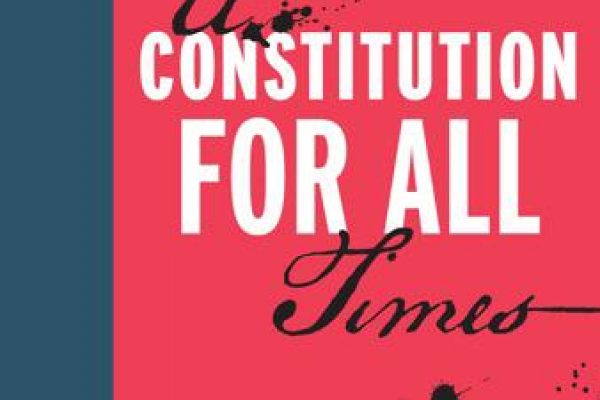People across the political spectrum believe that the constitutional system has failed badly. For progressives the failure is manifest in the White House and the Senate: our political system put in office a would-be authoritarian standing on top of a supine political party. Today’s failures are obvious, but the rot goes deeper. Our political parties are as polarized as they’ve ever been. That made it impossible to respond to the 2008 financial crisis with an economic program large enough to address its consequences fast enough. Our health care system is a mess in large part because the Affordable Care Act was cobbled together so that it could get through the Senate without a filibuster. But what is to be done?
What would the project of constitutional reform look like if we instead thought more deeply about the way political institutions are embedded in the economy?
Ideas about amending the Constitution have gotten some traction among progressives recently. In June the American Academy of Arts and Sciences issued a nominally bipartisan report, “Our Common Purpose: Reinventing American Democracy for the 21st Century,” with thirty-one recommendations for changing our institutions to promote a “reinvention” of democracy for this century. And the National Constitution Center has created a commission to “propose solutions and ways to ensure the future of American democracy.”
These discussions of constitutional revisions proceed mostly by listing specific problems and solutions: the Electoral College, the distorted representation in the Senate, life tenure for federal judges, a campaign finance system dominated by the rich. The Common Purpose report, for example, recommends expanding the House of Representatives to make it and the Electoral College “more representative of the nation’s population,” setting a term limit of eighteen years for Supreme Court justices, and adopting a constitutional amendment to allow reasonable campaign finance regulations. In a few preliminary paragraphs the report considers the broader stakes, asserting that our current situation arises from a decline in “civic faith.” It goes on to argue that constitutional changes should promote “a virtuous cycle in which responsive political institutions foster a healthy civic culture of participation and responsibility” and that civic culture “keeps our political institutions responsive and inclusive.”
Focusing on civic culture and political institutions—including the way they interact—is exactly right. But the report’s treatment of civil society is far too thin. It is also so deeply committed to our current economic arrangements that implementing its recommendations would more likely reproduce elite domination of civic culture than dismantle it. Among the proposals are calls for “private enterprise and philanthropic seed funding” and “a range of funders to invest in the leadership capacity of . . . catalytic leaders who drive civic renewal.” The ultimate vision is for “a philanthropic initiative to support the growing civil society ecosystem of civic gatherings and rituals focused on the ethical, moral, and spiritual dimensions of our civic values.”
But what if the decay of civic culture stems from the very structures of economic power that make such philanthropy possible? What would the project of constitutional reform look like if we instead thought more deeply about the way political institutions are embedded in the economy? If we are truly committed to revitalizing democracy, we must consider more thoroughgoing changes to constitutional design from the ground up.
• • •
To do that, we need a clear goal. At a most basic level, we want a constitutional republic that secures the general welfare and ensures liberty and justice for all. And we want that republic to be able to sustain itself in the face of many kinds of shocks: an invasion by a foreign enemy, a pandemic, severe economic stress, and—as important today as in 1789—the recurring risk that an authoritarian leader might somehow come to power.
Constitutional reforms should aim both at shaking up the party system and at combating the corrosive force of capitalism on civic virtue.
Two traditions in political philosophy address the problem of designing such a self-sustaining constitutional republic. The first is what political theorist Judith Shklar called a liberalism of fear. Its primary concerns are authoritarian leadership and threats to liberty, and its solution lies in public institutions—legislatures and courts, both national and state—that make it hard for an authoritarian leader to carry out his plans. These institutions are staffed by people who have an interest in opposing the leader and institutions that can thwart attempted assaults on liberty. Our system of separation of powers creates what political scientists call veto-gates that slow down the authoritarian’s advances. And our system of judicial review is supposed to stop the other branches of government from violating our rights.
The second tradition has its roots in what today’s political theorists call civic republicanism. Here the idea is to create institutions—including forms of civic education—that make it likely that voters will want to sustain a constitutional republic. James Madison thought that some features of the U.S. Constitution would have that effect. Elections of representatives from relatively large districts, he argued, would lead voters to choose people who had demonstrated commitment to constitutionalism by performing public service that would make them well known. These representatives, Madison wrote, would “refine and enlarge the public views.” Civic republicans understood that political institutions are tied to economic ones. The institutions they usually invoked were not public, although the idea of federalism—devolving policy-making power to the states—had some connection to civic culture. (By making policy on the local level, the idea went, ordinary people would develop civic capacity generally.) Thomas Jefferson thought that farmers in their local communities would develop ties of friendship that would lead them to understand the value of a constitutional republic. The “doux commerce” thesis held that face-to-face commercial transactions would have a similar effect among traders.
Both traditions of constitutional design have their weaknesses. As for the liberalism of fear, the rise of political parties has produced what legal scholars Daryl Levinson and Richard Pildes call a system of separation of parties, not of powers. And as for civic republicanism, reality show TV stars trade on their celebrity rather than (as Madison thought) their service to the public as a means of gaining office, while large-scale capitalist organizations—not face-to-face exchange among individuals—dominate farming and commerce. Still, retrieving both traditions helps us understand the vices of the current system. Constitutional reforms should aim both at shaking up the party system and at combating the corrosive force of capitalism on civic virtue. That is not to deny the two traditions are in tension in some respects. Institutions that encourage civic virtue by disciplining capitalism do so by exercising public power, while those that respond to the liberalism of fear hobble the exercise of public power. Achieving the right balance is no easy task.
• • •
How are we to thread this needle? We might start with taglines from the 1960s that were revived by the Occupy movement in 2011: power to the people and participatory democracy. Taking seriously the insight Jefferson had about federalism—that actively making policy builds a democratic civic culture—we should devolve power radically. All public decisions should be made at the “lowest” level of governance where the policies can be implemented most effectively. Sometimes that means a neighborhood (or even an apartment building), sometimes a city, sometimes a state or region, and sometimes, of course, the nation as a whole. Drawing upon the social teachings of the Roman Catholic Church, constitutional theorists call this, more tamely, the “principle of subsidiarity.”
All public decisions should be made at the “lowest” level of governance where the policies can be implemented most effectively.
International courts have begun to endorse decision-making at this level by requiring that central authorities “engage” with local people when the center’s projects—sometimes infrastructure investment, sometimes economic development to fund social welfare programs—affects daily life in the locality. But “power to the people” also refers to more than public power. Labor movements around the world have historically sought to increase the power of workers to set the rules governing the workplace. And, again, when workers bring their shop-floor knowledge to bear on workplace policy, they develop a kind of capacity that translates into the public sphere as the civic culture we are looking for.
Local power can be abused, of course, which is one reason that the liberalism of fear remains important. Subsidiarity comes with the principle that higher levels of governance can overrule lower ones when the latter abuse their power. This logic leads ultimately to the proposition that Congress must have the power to displace every exercise of devolved power: how workers are protected from injury, how everyone is protected against environmental degradation, how local police behave, how mayors deal with demonstrations, and everything else.
This line of thought may seem to lead to a form of infinite regress. What can we do if we think that Congress has abused its power? We know the answer: create a Supreme Court with the power to find that Congress has violated the principle of subsidiarity. What, though, about a liberalism of fear applied to the Supreme Court? Experience with constitutional courts around the world suggests some design principles. An increasingly popular one allows legislatures to override court decisions they think wrong. One approach would be to allow an override when adopted by majorities in two congressional sessions separated by an election, but there are lots of variants that might satisfy the liberalism of fear’s concern about both Congress and the courts.
Another possibility is to follow Scandinavian constitutions in permitting the Supreme Court to hold a statute unconstitutional only if it is “manifestly” unreasonable. That’s not a complete solution either, because what is manifest to Brett Kavanaugh is not always going to be manifest to Elena Kagan. But constitutions are human products, and we do the best we can as we see the problems facing us.
With these principles in hand—or with whatever alternative basic principles we can agree upon in hand—we can turn to designing institutions in detail. Sometimes that might lead us to tinker with what we have (term limits for the Supreme Court, say). Sometimes it might lead us to more radical institutional choices—perhaps making the Senate like the British House of Lords, with the power only to delay the adoption of legislation when a Senate majority there thinks it unwise, leaving it to the House of Representatives to reflect upon the Senate’s concerns before making a final decision.
These changes—or indeed any other significant ones—are unlikely to be adopted in the next few years, of course. Whatever proposals progressives come up with can be implemented only after serious political mobilization. Movements can make possible policies that were almost unthinkable before them: just consider the 2020 version of the Black Lives Matter (BLM) movement and the idea of defunding the police. So, the fact that the kinds of institutional reforms I’ve sketched aren’t likely to be adopted in the near future really isn’t all that important. Rather, the question is, can putting them forward, creating forums in which they can be discussed, and agitating for their adoption foster a substantial political movement for constitutional change?
People aren’t likely to take to the streets waving signs saying, “Term limits for the Supreme Court” or even “Amend the Constitution now.” Traditional forms of mobilization aren’t well suited for a movement for constitutional reform.
Here we have to think about what such a movement would look like in the twenty-first century. BLM reproduces historic modes of political mobilization, with people going out on the streets and political candidates taking up the banner. But people aren’t likely to take to the streets waving signs saying, “Term limits for the Supreme Court” or even “Amend the Constitution now.” Traditional forms of mobilization aren’t well suited for a movement for constitutional reform. But today we have other modes of organizing, such as online forums open to all (with moderators who can throw out trolls).
Over the past decade Iceland went through a constitutional reform process that included substantial direct participation through online consultations in which ordinary citizens could suggest constitutional reforms, some of which were taken quite seriously. The reforms, which appear still to have majority support, have been blocked by the nation’s political parties, although they remain a matter of active political debate. In Ireland, “citizens’ assemblies” of ordinary people generated constitutional amendments dealing with marriage equality and women’s right to choose abortion. In an intriguing echo of actions taken before the American Revolution, political leaders supporting Catalan independence conducted an illegal “consultation” with Catalans—an in-person advisory vote on independence. It might be done the next time online, with less legal risk.
• • •
These are only a few examples, and when examined in detail the stories are messier—as all stories about real politics are. Traditional protest activities occurred in both Iceland and Catalonia, for example, before the innovative new technologies were deployed. Still, the examples suggest that new technologies of direct popular deliberation enable movements to work around opposition from established elites without taking to the streets, by building something on-line and then moving into the streets and the ballot box.
We should rethink our Constitution from the ground up.
We’re not going to get a good handle on the constitutional reforms essential to revitalizing democracy simply by listing the things that currently most nettle progressives and by hoping that the good sense embodied in reform proposals will carry the day. We have to understand how these flaws are symptoms of deeper vices in our constitutional system—and, in particular, how our economic and political arrangements combine to erode commitments among the people to sustaining a constitutional republic. We have to think about designing institutions that go as far as possible in creating a republic that is self-sustaining.
As we do so, we need not be beholden to what Abraham Lincoln called “the dogmas of the quiet past”—the constitutional design we have inherited and that has brought us to our current impasse. We should rethink our Constitution from the ground up. As Lincoln understood, “as our case is new, we must think anew and act anew. We must disenthrall ourselves, and then we shall save our country.”







